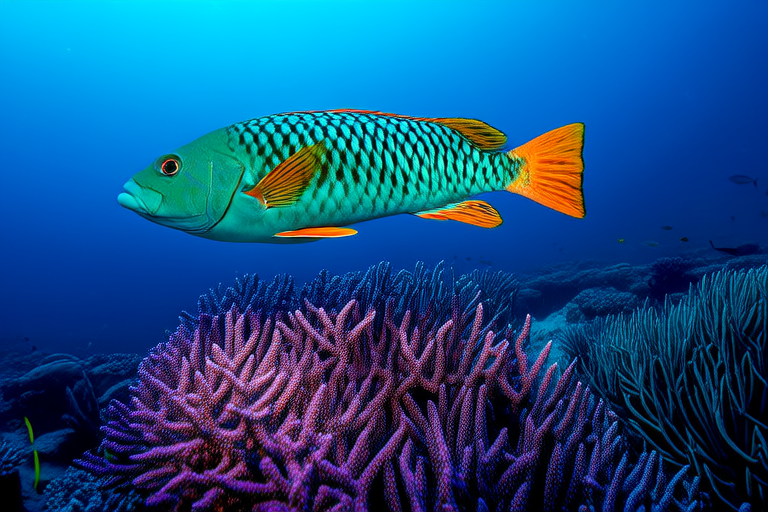The Life of Parrot Fish: From Coral Reefs to Aquariums
Introduction
Parrotfish, with their vibrant colors and unique physical characteristics, are one of the most captivating creatures found in coral reefs around the world. These fish play a crucial role in maintaining the health of these ecosystems. This article explores the life of parrot fish, beginning with their natural habitats, roles in reef ecosystems, behaviors, and dietary habits. It then transitions into how these fish are selected for aquariums, focusing on the challenges and considerations involved in their capture and transport. Finally, it discusses the adaptation of parrot fish to aquarium environments, including their care, specific needs, and the responsibilities of owners. The article concludes with insights on conservation efforts aimed at protecting parrot fish populations both in the wild and in captivity, emphasizing sustainable practices.
Natural Habitat and Role in Reef Ecosystems
Parrotfish inhabit tropical and subtropical waters, primarily living within coral reefs. These reefs provide them with shelter, food, and breeding grounds. Parrotfish are known for their distinctive beak-like mouths, which they use to scrape algae off rocks and corals. This feeding behavior is vital for the maintenance of coral reefs as it helps control the growth of algae that can smother corals. By preventing algal overgrowth, parrotfish contribute to the overall health and biodiversity of the reef ecosystem.
Parrotfish also play a significant role in the formation of sand. Their digestive process breaks down the calcium carbonate structures of corals and other organisms, excreting it as fine sand. This contributes to the formation of beaches and islands in many tropical regions.
Behaviors and Dietary Habits
Parrotfish exhibit various behaviors that are fascinating to observe. They are generally diurnal, meaning they are active during the day. Many species form large schools, especially when young, which provides protection against predators. As they mature, they tend to become more solitary or form smaller groups. Some parrotfish species change color and sex as they age, a phenomenon known as sequential hermaphroditism. Initially, most parrotfish are born female and later transition to male if necessary.
Dietary habits of parrotfish vary slightly depending on the species, but they primarily feed on algae and detritus found on coral reefs. Their beak-like mouths allow them to scrape algae off rocks and corals efficiently. Additionally, some species may consume small invertebrates, such as worms and mollusks. The diet of parrotfish plays a critical role in the nutrient cycling within the reef ecosystem, ensuring a balanced environment for all marine life.
Selection for Aquariums
Selecting parrotfish for aquariums involves several challenges and considerations. Wild-caught parrotfish are often chosen for their vibrant colors and unique appearance, making them popular among aquarists. However, capturing these fish can be challenging due to their agility and the complexity of their natural habitats. Fishermen typically use nets or spears to catch parrotfish, but this method can be harmful to both the fish and the surrounding environment.
Transporting parrotfish from their natural habitats to aquariums is another significant challenge. Proper handling and packaging are essential to ensure the survival of the fish during transit. Aquarists must consider factors such as water quality, temperature, and oxygen levels during transportation. Ethical considerations also come into play, as the capture and transport of parrotfish can have negative impacts on wild populations if not managed sustainably.
Adaptation to Aquarium Environments
Once in an aquarium, parrotfish require specific care and conditions to thrive. Providing an appropriate environment is crucial for their well-being. A spacious tank with plenty of hiding spots and ample swimming space is ideal. Parrotfish need clean water with stable pH and temperature levels. Regular water changes and filtration systems are necessary to maintain water quality. Feeding parrotfish in captivity requires a diet similar to their natural one, consisting mainly of algae-based foods. Supplemental protein sources, such as frozen or live foods, can also be provided to ensure a balanced diet.
Owners of parrotfish in aquariums must be aware of the fish’s specific needs and take responsibility for their care. Regular monitoring of water parameters, proper feeding, and providing suitable hiding places are essential for the health and happiness of these fish. Additionally, owners should be mindful of the potential impact of their choices on wild populations and strive to support sustainable practices.
Conservation Efforts
Protecting parrot fish populations both in the wild and in captivity is crucial for their survival and the health of coral reef ecosystems. Conservation efforts focus on sustainable fishing practices, habitat preservation, and responsible aquarium management. Sustainable fishing practices aim to minimize the impact on wild populations by setting catch limits and using methods that reduce bycatch. Habitat preservation involves protecting coral reefs and other marine environments from degradation caused by pollution, climate change, and human activities.
Responsible aquarium management includes promoting ethical sourcing of fish and supporting initiatives that encourage captive breeding. Captive breeding programs can help reduce the demand for wild-caught fish and provide a sustainable source of parrotfish for the aquarium trade. Additionally, raising awareness about the importance of conservation and encouraging responsible ownership can contribute to the protection of parrotfish populations.
In conclusion, understanding the life of parrot fish, from their natural habitats in coral reefs to their adaptation to aquarium environments, highlights the importance of sustainable practices in maintaining healthy populations both in the wild and in captivity. By supporting conservation efforts and taking responsibility for the care of these magnificent creatures, we can ensure the continued existence of parrot fish for future generations.
